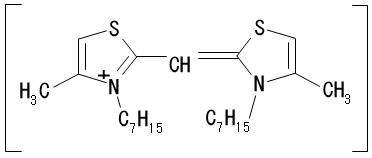√ Highly efficient with very low dose of use
- Borad activity to resist bacteria, fungi and pathogens.
- 0.00002% PIONIN ® can inhibit the growth of propionibacterium acnes
- 0.00001% PIONIN ® can inhibit 83 % melanin formation
√ Anit-acne: quickly and significantly reduce spots
- Reduce 50% of spots or rashes within 2 weeks
√ Preservative activity: improve the efficacy of parabens or completely replace them
√ High security
√ Compliant with Japanese Quasi Drugsto be used in anti-acne products
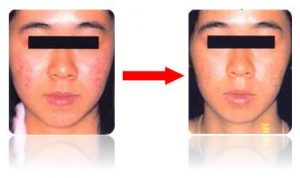
Anti-acne, whitening, anti-freckle
Highly efficient molecule in anti-bacteria & anti-melanin
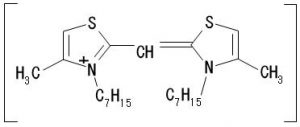
PIONIN ® similar to cyanine dyes. Even a single PIONIN ® molecule also has anti-bacterial activity, which is the reason why PIONIN ® is still efficient even with an extremely low dose:
- resistant to propionibacterium acnes and inhibits melanin production.
- improves the corrosion resistance of finished products
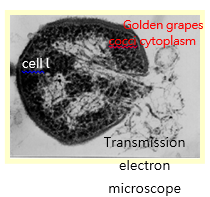
By causing collapse of cell membrane and cell wall and intracelluar degradation, PIONIN® will damage the microorganisms.
Inhibits bacteria and fungi with an extremely low dose of use ( In vitro test )
In vitro test (see table below, agar plate dilution) proves that the extremely low dose of use of PIONIN ® can also inhibit a wide range of bacteria and fungi. The lowest concentration of PIONIN ® used to inhibit bacterial growth is called the Minimum Inhibitory Concentration (MIC).
| Bacterial names ( Unfinished ) | MIC % |
| Liquid achromobacter sp | 0.001 |
| Enterobacteriaceae | 0.01 |
| Botulinum toxin | 0.005 |
| Escherichia coli | 0.01 |
| Brown flavobacterium | 0.001 |
| Proteusbacillus vulgaris | 0.001 |
| Pseudomonas aeruginosa | 0.1 |
| Salmonella enteritidis | 0.005 |
| Staphylococcus aureus | 0.0005 |
| Staphylococcus citrate | 0.001 |
| Fungi names ( Unfinished ) | MIC % |
| Absidia orchidis | 0.0001 |
| Tinea capitis fungus | 0.001 |
| Black aspergillus | 0.005 |
| Aspergillus flavus | 0.0005 |
| Candida albicans | 0.001 |
| Epidermophyton floccosum | 0.0001 |
| Gypsum-like microsporum | 0.0001 |
| Soft rot rhizopus nigricans | 0.001 |
| Saccharomyces sake | 0.001 |
| Zygosaccharomyces | 0.0005 |
Strong inhibition of melanin
PIONIN ® can prevent the formation of melanin. In vitro test indicates that:
- 0.000003% PIONIN ® can suppress 50% melanin formation
- 0.00001% PIONIN ® can suppress 83% melanin formation.
In contrast, 0.07% kojic acid can inhibit 100% melanin formation.
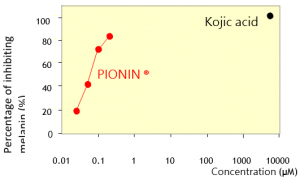
Highly safe and non-irritant
- Human body patch test ( human body, 0.2%, 48 hours ): negative
- Initial skin irritation ( rabbit, 0.2%, 24 hours ): negative
- Sustained skin irritation ( rabbit, 0.01%, 90 day ):negative
- Eye irritation ( rabbit, 0.0007%, 24 hour ): negative
- Skin sensitization ( Guinea pig, 0.2%, maximum test ): negative
- Phototoxicity ( rabbit, 0.2%): negative
- Photosensitization ( Guinea Pig, 0.2%, Adjuvant-Strip Method ): negative
- Induced gene mutation (10μg, Ames test, ±S9 mix): negative
- Acute Toxicity LD 50 ( mouse ):325 mg/kg
Fast & deep effect on anti-acne
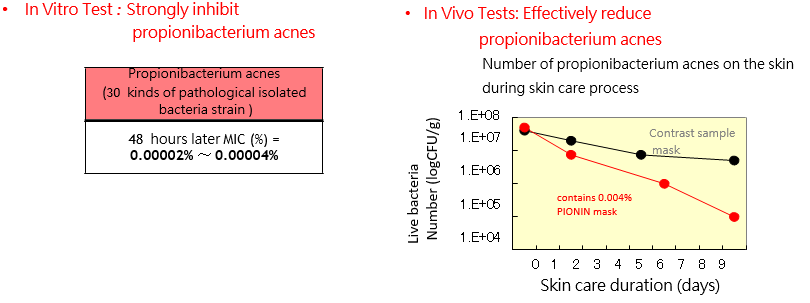
Clinical Test: Within two weeks, it reduced 50% spots
Testing program: Carry out test in 38 testees with acne problems
Method: Wash face 3 times every day with emulsion containing 0.001% of PIONIN and smears twice a week with cream containing 0.005% of PIONIN.
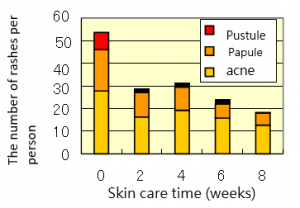
Bactericidal activity : PIONIN can be used as a preservative
The PIONIN ®’s bactericidal ability allows it to be used as a preservative. In vitro test data shows that in term of anti-bacteria and anti-fungi of various kinds, PIONIN ® is more effective than paraben methyl ester. Therefore, just adding a small amount of paraben in the formulation containing PIONIN ® is enough to achieve an antibacterial effect.
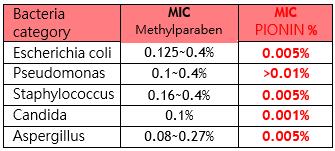
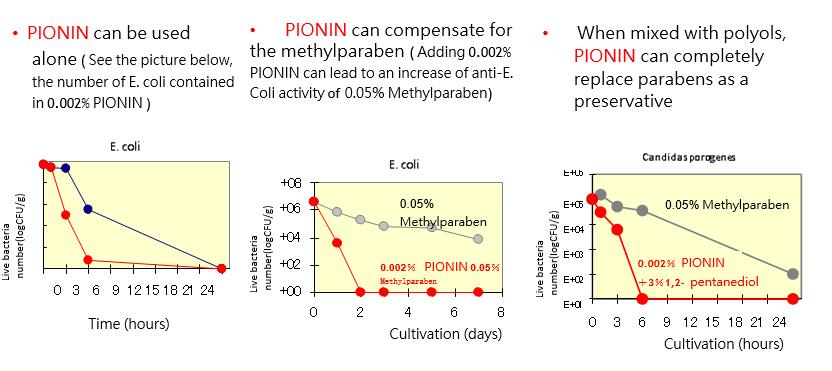
Application : Aniti-acne, anti-freckle, whitening, cleansing
• Anti-acne, oily skin, anti-freckle
• Whitening
• Cleaning formula, hand cream
Definition
• Commodity names : PIONIN ®
• English name : BIOXYNE
• INCI name : Quaternary Ammonium Salt -73
• China INCI (2007): has been included
• China INCI (2010): has been included
• CAS#: 15763-48-1
• EINECS#: 239-852-5
• Related regulations : Compliant with Japanese Quasi-drugs for using in acne products.
Formula Guidelines
| Dose of use | 0.001%~0.005% |
| Suitable pH | 5.5 – 8 |
| Solubility | butylene glycol ,propylene glycol,ethanol,1,2– pentanediol |
| Thermal Stability | Up to 90 °C |
| Operation Guide | Since PIONIN is slightly soluble in water, we recommend dissolving it in ethylene glycol and ethanol before adding the formula. It is recommended to keep the solvent in the boiling water and at the same time stir and mix them when dissolving PIONIN. |
| Photostability | Unstable; cosmetic products containing PIONIN need to be canned in opaque containers. |
| Existing Information | Overview, technical materials, PPT, technical indicators, MSDS |
Technical indicators
| Appearance | Crystal powder |
| Colour | Light yellow to yellow |
| Odor | Odorless |
| Purity (HPLC) | > 97% |
| Maximum absorption | 411 +/- 2 nm |
| Melting point | 224 – 228 ° C |
| Loss on drying (90℃,3 hours ) | < 0.5% |
| Ash | < 0.2% |
| Arsenic | < 2 ppm |
| Heavy metal (Pb) | < 10 ppm |
Storage
| Sample Specifications | 0.1g |
| Packaging | 5g |
| Quality guaranteed period | 3 years |
| Storage | Stored in a cool, dry, dark place |
| Use | Special care is taken to prevent the powder from diffusing into the air. Wear a mask to avoid inhaling powder. After use please wash your body, hands, mouth and face thoroughly (see MSDS). |
The information in this publication is based on accuracy and integrity. However, we do not provide any guarantee or assurance for the information given because of circumstances beyond our control. Every customer should evaluate our products according to their actual needs. The information listed above is not the same as the recommended information of our products, as it may infringe the patents of other interested parties.
